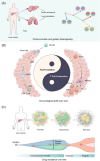Spatial‒temporal heterogeneities of liver cancer and the discovery of the invasive zone
- PMID: 39924620
- PMCID: PMC11807767
- DOI: 10.1002/ctm2.70224
Spatial‒temporal heterogeneities of liver cancer and the discovery of the invasive zone
Abstract
Solid tumours are intricate and highly heterogeneous ecosystems, which grow in and invade normal organs. Their progression is mediated by cancer cells' interaction with different cell types, such as immune cells, stromal cells and endothelial cells, and with the extracellular matrix. Owing to its high incidence, aggressive growth and resistance to local and systemic treatments, liver cancer has particularly high mortality rates worldwide. In recent decades, spatial heterogeneity has garnered significant attention as an unfavourable biological characteristic of the tumour microenvironment, prompting extensive research into its role in liver tumour development. Advances in spatial omics have facilitated the detailed spatial analysis of cell types, states and cell‒cell interactions, allowing a thorough understanding of the spatial and temporal heterogeneities of tumour microenvironment and informing the development of novel therapeutic approaches. This review illustrates the latest discovery of the invasive zone, and systematically introduced specific macroscopic spatial heterogeneities, pathological spatial heterogeneities and tumour microenvironment heterogeneities of liver cancer.
Keywords: immunosuppression; invasive zone; liver cancer; spatial heterogeneity; tumour microenvironment.
© 2025 The Author(s). Clinical and Translational Medicine published by John Wiley & Sons Australia, Ltd on behalf of Shanghai Institute of Clinical Bioinformatics.
Conflict of interest statement
The authors declare they have no conflicts of interest.
Figures









Similar articles
-
Heterogeneity in Liver Cancer Immune Microenvironment: Emerging Single-Cell and Spatial Perspectives.Semin Liver Dis. 2024 May;44(2):133-146. doi: 10.1055/s-0044-1787152. Epub 2024 May 24. Semin Liver Dis. 2024. PMID: 38788780 Review.
-
Beyond Cancer Cells: How the Tumor Microenvironment Drives Cancer Progression.Cells. 2024 Oct 9;13(19):1666. doi: 10.3390/cells13191666. Cells. 2024. PMID: 39404428 Free PMC article. Review.
-
The matrix environmental and cell mechanical properties regulate cell migration and contribute to the invasive phenotype of cancer cells.Rep Prog Phys. 2019 Jun;82(6):064602. doi: 10.1088/1361-6633/ab1628. Epub 2019 Apr 4. Rep Prog Phys. 2019. PMID: 30947151 Review.
-
Role and value of the tumor microenvironment in the progression and treatment resistance of gastric cancer (Review).Oncol Rep. 2025 Jan;53(1):14. doi: 10.3892/or.2024.8847. Epub 2024 Nov 29. Oncol Rep. 2025. PMID: 39611496 Free PMC article. Review.
-
Mix and Match: Phenotypic Coexistence as a Key Facilitator of Cancer Invasion.Bull Math Biol. 2020 Jan 17;82(1):15. doi: 10.1007/s11538-019-00675-0. Bull Math Biol. 2020. PMID: 31953602 Free PMC article.
Cited by
-
Targeting immune checkpoints in hepatocellular carcinoma therapy: toward combination strategies with curative potential.Exp Hematol Oncol. 2025 May 2;14(1):65. doi: 10.1186/s40164-025-00636-5. Exp Hematol Oncol. 2025. PMID: 40317077 Free PMC article. Review.
-
Immunotherapy targeting liver cancer tumor-initiating cells: challenges, mechanisms, and emerging therapeutic horizons.Front Immunol. 2025 Jun 11;16:1621243. doi: 10.3389/fimmu.2025.1621243. eCollection 2025. Front Immunol. 2025. PMID: 40568600 Free PMC article. Review.
References
-
- Chen W, Zheng R, Baade PD, et al. Cancer statistics in China, 2015. CA Cancer J Clin. 2016;66(2):115‐132. - PubMed
-
- Sung H, Ferlay J, Siegel RL, et al. Global Cancer Statistics 2020: GLOBOCAN estimates of incidence and mortality worldwide for 36 cancers in 185 countries. CA Cancer J Clin. 2021;71(3):209‐249. - PubMed
-
- Yang Y, Li M, Luo J, Yu H, Tian H, Wang X. Non‐hemodynamic effects: repurposing of nonselective beta‐blockers in cirrhosis? Portal Hypertens Cirrhosis. 2022;1(2):153‐156.
-
- Beal EW, Gorji L, Volney J, Sova L, McAlearney AS. Tsung A. Barriers to surveillance for hepatocellular cancer among patients with chronic liver disease‐providers' perspectives. Hepatoma Res. 2023;9:45.
Publication types
MeSH terms
Grants and funding
- Outstanding Resident Clinical Postdoctoral Program of Zhongshan Hospital Affiliated with Fudan University
- 82150004/Original Discovery Program of the National Natural Science of China
- Shanghai Municipal Science and Technology Major Project
- 2019CXJQ02/Shanghai Municipal Health Commission Collaborative Innovation Cluster Project
- 201940075/Shanghai Municipal Health Commission Collaborative Innovation Cluster Project
LinkOut - more resources
Full Text Sources
Medical
